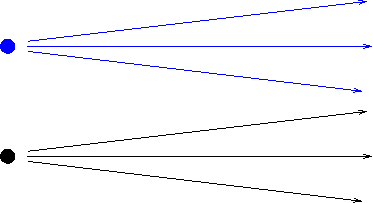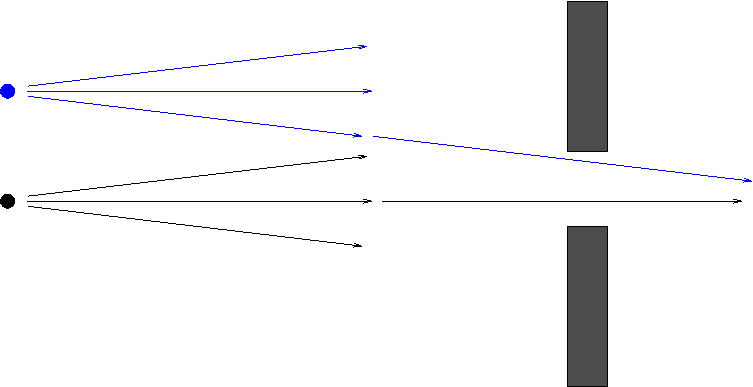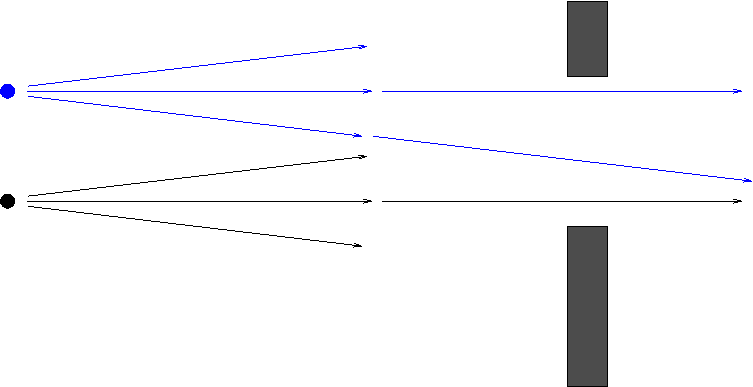Date: Sat Dec 6 11:09:15 2003
Posted By: Michael Richmond, Faculty, Physics, Rochester Institute of Technology
Area of science: Physics
ID: 1070635581.Ph
Message:
So you want to make light rays from the Sun into a parallel bundle?
This is a bit more complicated than it might seem at first glance,
due to the appreciable angular size (half a degree) of the Sun.
Let me try to explain the problem.
One often deals with light rays emanating from a single point source,
like those shown in Figure 1.

If one observes these rays at some small
distance from the source, the rays are not parallel. However, they
do follow a simple rule: the rays above the middle are tilted upwards,
and the rays below the middle are tilted downwards. The further away
from the middle of the bundle, the larger the tilt. You can design
a lens or a mirror to correct these rays so that they all become parallel;
all you have to do is adjust the surface of the lens (or mirror) so that
its properties at some distance above or below the optical axis make
the proper correction to the light rays at that position.
However, if you are dealing with a light source of appreciable extent,
things are more complicated. Look at Figure 2, which shows two point
sources some distance apart; you might consider these to be the middle
and edge of the solar disk.

Each source emits its own bundle of rays,
which diverge separately as they move towards the right. Note that
some of the black rays ARE parallel to some of the blue rays ... but other
black rays ARE NOT parallel to some of the blue rays. That's the problem.
There's no simple rule which connects the position of an arbitrary light
ray to its tilt.
What can you do about this? Well, you can simply things by selecting
only a small subset of all the light rays from the Sun. Look at
Figure 3, which there's an opaque wall with a small hole. If you
pay attention only to the light rays which pass through the hole,
then once again there is a simple relationship between the location
of a particular light ray and its tilt.

You can see that the blue
ray is tilted relative to the black ray, and it is also above it.
If there were another point source below the black one -- say, a red
source at the opposite edge of the solar disk -- then the only rays
from that source which would go through the hole would be both
below the black rays, and tilted the other way. You can easily design
a lens or mirror to take just the rays which pass through the hole
and make them all parallel.
However, as Figure 4 shows, the larger you make the hole, the harder
it becomes to make all the light rays parallel.

You can see here,
with a large hole in the wall, that some light rays from the blue
source which pass through the hole are parallel to the black light
rays, but other light rays from the blue source are NOT parallel
to the black rays. I think you could figure out a way to design
a lens or mirror which would make all the blue rays which passed
through the hole parallel to each other ... or one which made
some of the blue rays and some of the black rays parallel ... but
I don't think you could make all the blue rays and all the black
rays which pass through this hole parallel.
In summary, I think that if you want to have a very parallel set
of light rays, you may need to include a small pinhole in your
optical system. On the other hand, if you want a lot of light
rays, you'll need a big hole, or no hole at all, in which case
the resulting rays won't be very parallel. I think you'll need
to decide exactly what is most important to you -- parallel rays,
or lots of rays -- and then make your system accordingly.
Of course, if all you care about is LOTS of rays, and only a
very approximate degree of parallel-ness (ugh, is that a word?),
you can use no mirrors and no lenses; the rays from the Sun are
less than a degree away from a parallel beam naturally.
Current Queue |
Current Queue for Physics |
Physics archives
Try the links in the MadSci Library for more information on Physics.
MadSci Home | Information |
Search |
Random Knowledge Generator |
MadSci Archives |
Mad Library | MAD Labs |
MAD FAQs |
Ask a ? |
Join Us! |
Help Support MadSci
MadSci Network,
webadmin@www.madsci.org
© 1995-2003. All rights reserved.



